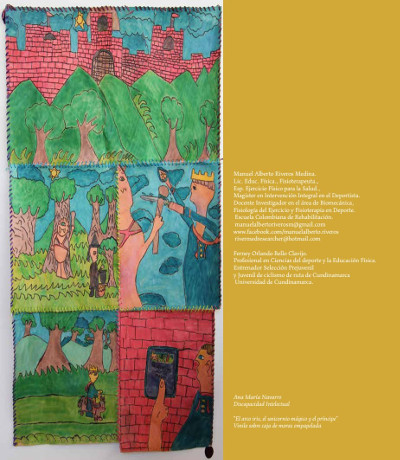Ergonómia y deporte de ciclista con displasia de cadera y acortamiento de miembros inferiores
Contenido principal del artículo
Autores
Manuel Alberto Riveros Medinamanuelalbertoriverosm@gmail.com
Ferney Orlando Bello Clavijo
revista@ecr.edu.co
Resumen
Este artículo presenta el ajuste mecánico más eficiente para mejorar la ergonomía y el rendimiento en un ciclista con displasia de cadera y acortamiento de 4 centímetros en su miembro inferior izquierdo. Abordar esta problemática permite encontrar nuevas alternativas que favo- rezcan los procesos de adaptación biológica de los sistemas neuromuscular y óseo en deportistas en situación de discapacidad. En éstas áreas, de la salud y rendimiento deportivo, se perciben vacíos que requieren generación de nuevo conocimiento. Fue un estudio pre- experimental de replicación intrasujeto. Se utilizaron varios ajustes mecánicos en la longitud de la biela de la bicicleta y la acomodación de tacos de diferente longitud a las zapatillas del deportista. Posteriormente se compararon los efectos de los ajustes mecánicos, buscando mejorar la ergonomía y eficiencia del deportista. Las variables fueron: anatómicas (postura sedente sobre la bicicleta), fisiológicas (comportamiento frecuencia cardiaca) y biocinemáticas (tiempos y velocidades promedio y ángulos articulares de rodilla tanto para la flexión como para la extensión en cada uno de los ajustes) datos que fueron registrados en planilla de Excel 2007. Al comparar el efecto de los ajustes mecánicos con la medición inicial, se encontró que el mejor ajuste para la ergonomía y el rendimiento del deportista corresponde a la combinación del taco 1 cm y biela 15,5 cm, con porcentajes de mejora en la variable morfológica alineación postural sobre la bicicleta de 71.4%; variables biocinemáticas mejoras en los tiempos en 1 km y 3 km en un 94.4% y 88.71%; y en cuanto a velocidades alcanzadas obtuvo mejoras en 1 km y 3 km del 115% y 118% respectivamente.
Palabras clave:
Detalles del artículo
Licencia
Aquellos autores/as que tengan publicaciones con esta revista, aceptan los términos siguientes:
- Los autores/as conservarán sus derechos de autor y garantizarán a la revista el derecho de primera publicación de su obra, el cuál estará simultáneamente sujeto a la Licencia de reconocimiento de Creative Commons que permite a terceros compartir la obra siempre que se indique su autor y su primera publicación esta revista.
- Los autores/as podrán adoptar otros acuerdos de licencia no exclusiva de distribución de la versión de la obra publicada (p. ej.: depositarla en un archivo telemático institucional o publicarla en un volumen monográfico) siempre que se indique la publicación inicial en esta revista.
- Se permite y recomienda a los autores/as difundir su obra a través de Internet (p. ej.: en archivos telemáticos institucionales o en su página web) antes y durante el proceso de envío, lo cual puede producir intercambios interesantes y aumentar las citas de la obra publicada. (Véase El efecto del acceso abierto).
Los autores que publican en la revista se acogen al código de licencia de Creative Commons Atribución 4.0 Internacional (CC BY 4.0)




Referencias
Baker, A. (2002). Medicina del ciclismo. Barcelona: editorial paiditrobo.Bolourchi, F. & Hull, M.L. (1985). Measurement of rider induced loads during simulated bicycling. International Journal Sport Biomechanics. 1. (308-329).
Cavanagh, P.R. & Sanderson, D.J. (1986). I be biomechanics of cycling studies of the pedalling mechanics of elite pursuit riders. Ed: Science of cycling. Champaigh II. Human Kinetics. (27-30)
Delore, M. (1998). Preparación y entrenamiento del ciclista. Barcelona: hispano europea.
Faria, I.E. & Cavanagh, P.R. (1978). The Physiology and Biomechanics of Cycling. New York: John Wiley and Sons.
García-López J, Rodríguez-Marroyo JA, Juneau CE, Peleteiro J, Martínez AC, Villa JG. (2008). Reference values and improvement of aerodynamic drag in professional cyclists. J Sports Sci. 26 (3): 277–286.
García-López, S. Díez-Leal, J.A. Rodríguez-Marroyo, J. Larrazabal, I.G. de Garceano, J.G., Villa. (2009). eficiencia mecánica de pedaleo en ciclistas de diferente nivel compettivo. Biomecánica, 17 (2), pp. 9-20.
González, H. & Hull, M.L. (1989). Multivariable optimization of cycling biomechanics. Journal of biomechanics. 22, 11, 1151-1161.
Gregor, R.J.; Broker, J.P. & Ryan, M.S. (1991). The biomechanics of cycling. Exercise and sport sciences reviews. 19. (127-169).
Hue O, Galy O, Hertogh C, Casties JF, Prefaut Ch. (2001). Enhancing cycling performance using an eccentric chainring. Med Sci Sports Exerc. 33:1006-1010.
Hull, M.L. & Davis, R.R. (1981). Measurement of pedal loading in bicycling. Instrumentation. Journal of biomechanics. 14. (843-855).
Jorge, M. & Hull, M.L. (1986). Anakysis of EMG measurements during bicycle pedalling. Journal of biomechanics. 19, 9, 683-694.
Kautz, S.A. & Hull, M.L. (1993). A theorical basis for interpreting the force applied to the pedal in cycling. Journal of biomechanics. 26, 2 (155-165).
Kyle, C.R. (1989). The aerodynamics of handlebars and helmets. Cycling Science. 1, 22-25.
Kyle, C.R. (1990). Wind tunnel tests of bicycle wheels and helmets. Cycling Science. 2, 27-30.
LaFortune, M.A. (1986). Cycling from a biomechanical perspective. Sport Sciences Medicine. 2. (8-10).
Martin JC, Lamb SM, Brown AT. (2002). Pedal trajectory alters maximal single-leg cycling power. Med Sci Sports Exerc. 34: 1332-1336.
McArdle, W. D. (2004). Fundamentos de fisiología del ejercicio. Madrid: Mc-Graw-Hill Interamericana pag. 320.
McCormick, M. (1993). Seeking perfection with the force pedal. Velo-news.8, 62 65.
Noret, A. y Bailly L. (1991). El ciclismo. Paris Francia: hispano europea.
Riveros, M. A. (2009). Biomecánica aplicada a la actividad fisica y el deporte.Bogotá.
Santalla A, Manzano JM, Pérez M, Lucía A. (2002). A new pedaling design: the Rotor-effects of cycling performance. Med Sci Sports Exerc. 34: 1854- 1858.
Soden, P.D. & Adeyefa, B.A. (1979). Forces applied to a bicycle during normal cycling. Journal of Biomechanics. 12. (527-541).
Tortosa L.G.C. (1999) Ergonomía y discapacidad. Instituto de biomecánica de valencia: Valencia. paidotribo.
Zameziati K, Mornieux G, Rouffet D, Belli A. (2006). Relationship between the increase of effectiveness indexes and the increase of muscular efficiency with cycling power. Eur J Appl Physiol. 96(3): 274–281
Zintl, F. (1991). Entrenamiento de la resistencia. Barcelona: Martínez Roca.


 PDF
PDF
 XML
XML










